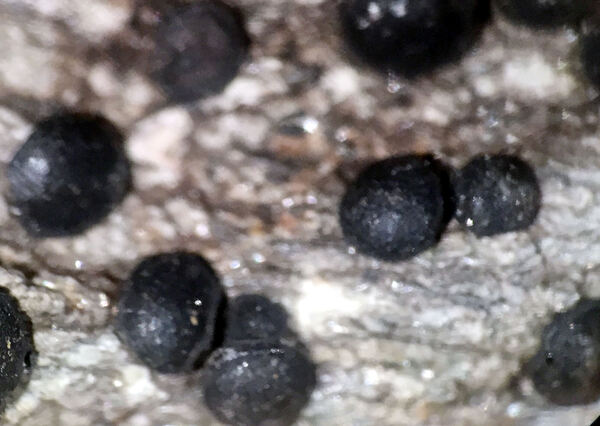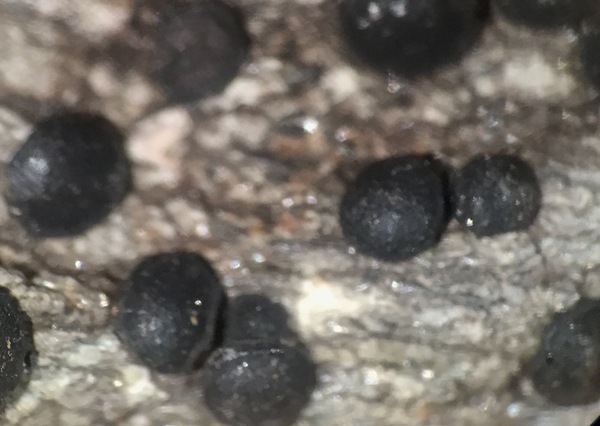Porpidia superba (Körb.) Hertel & Knoph
in Hertel, Beih. Nova Hedwigia, 79: 438, 1984. Basionym: Lecidea superba Körb. - Syst. Lich. Germ.: 248, 1855.
Synonyms: Huilia superba (Körb.) Hertel; Lecidea incrassata H. Magn.; Lecidea macrocarpa var. superba (Körb.) Th. Fr.
Distribution: N - TAA (Nascimbene & al. 2022), Piem (Isocrono & al. 2004).
Description: Thallus crustose, episubstratic, bullate-areolate, the areoles usually convex, often well-separated from each other, chalky white, more rarely creamy white or very pale grey, scabrid, rarely delimited by a black prothallus. Soredia sometimes present, formed in the cracks of the thallus, granular, concolorous with the thallus. Medulla white, I-. Apothecia lecideine, at first immersed at margins of areoles, later sessile, 0.5-1.5(-2) mm across, with a brown to black-brown, red-brown when wet, sometimes (especially when young) white-pruinose, flat to finally slightly convex disc and an epruinose, rather thick, undulate, black proper margin. Proper exciple thick, dark brown throughout (a paler inner area visible on very thin sections only), of radiating hyphae; epithecium brownish to orange-brown, c. 20 µm high, N+ orange, K-; hymenium colourless, 90-150 μm high; paraphyses strongly coherent, branched in upper part and richly anastomosing, 1.5-2 µm thick at mid-level, the apical cell to 4 µm wide; hypothecium thick, brown-black. Asci 8-spored, elongate-clavate, with a thin, outer amyloid layer and a thickened tholus penetrated by a pore, the sides of which are strongly amyloid, Porpidia-type. Ascospores 1-celled, hyaline, ellipsoid to ovoid, (16-)19-28(-33) x (6-)8-12(-14) μm, thin-walled, halonate when young. Photobiont chlorococcoid. Spot tests: thallus K-, C-, KC-, P-; medulla sometimes K+ yellow, P+ orange-yellow. Chemistry: without lichen substances, or medulla with stictic acid (usually in low amounts, or in traces).Note: a mainly arctic-alpine lichen found on weakly calciferous or basic siliceous rocks in sheltered situations near or above treeline. An earlier record from Emilia (see Nimis 1993: 570), being dubious, is not accepted here.
Growth form: Crustose
Substrata: rocks
Photobiont: green algae other than Trentepohlia
Reproductive strategy: mainly sexual
Commonnes-rarity: (info)
Alpine belt: very rare
Subalpine belt: very rare
Oromediterranean belt: absent
Montane belt: absent
Submediterranean belt: absent
Padanian area: absent
Humid submediterranean belt: absent
Humid mediterranean belt: absent
Dry mediterranean belt: absent

Predictive model
Herbarium samples
Growth form: Crustose
Substrata: rocks
Photobiont: green algae other than Trentepohlia
Reproductive strategy: mainly sexual
Commonnes-rarity: (info)
Alpine belt: very rare
Subalpine belt: very rare
Oromediterranean belt: absent
Montane belt: absent
Submediterranean belt: absent
Padanian area: absent
Humid submediterranean belt: absent
Humid mediterranean belt: absent
Dry mediterranean belt: absent

Predictive model
| Herbarium samples |
 INDEX FUNGORUM
INDEX FUNGORUM
 GBIF
GBIF
 DOLICHENS
DOLICHENS




